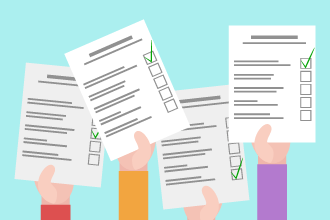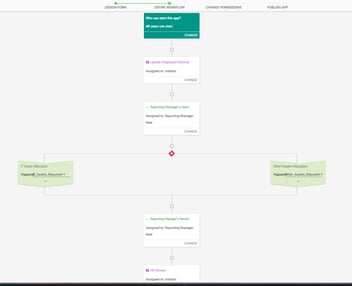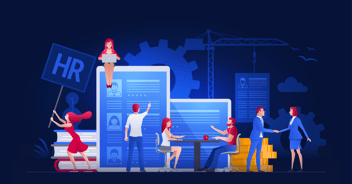
- >
- Human Resources >
- Employee Onboarding Process: The HR Manager’s Guide to Automation
Employee Onboarding Process: The HR Manager’s Guide to Automation
HR Managers face numerous challenges on a day-to-day basis, but none more intense than recruitment and employee onboarding. The demand is insatiable, but the talent pool continues to shrink steadily. Succeeding in the quest to find the right candidate despite the talent crunch has become more important than ever. But after finding the right person, an even larger challenge begins.
After devoting endless hours searching for, identifying, interviewing, and recruiting the right talent, if the new hire ends up quitting for a greener landscape, all your hard work will go down the drain, and you are back to step one. Or, what if a candidate accepts an offer, confirms the notice period, agrees to a date of joining, but backs out at the last minute?

Can a more structured employee onboarding implemented using a defined employee onboarding process really prevent something like this? Would it really increase employee engagement, invoke a sense of loyalty in new hires and in turn, improve employee retention rate?
What Is Onboarding in HR?
"Onboarding" refers to the organized set of procedures designed to integrate new hires into an organization, involving tasks like attending an introductory orientation, familiarizing themselves with the company's hierarchy and culture, and grasping its goals and principles.
What is employee onboarding?
The definition of employee onboarding differs from one organization to another. While the process tends to be almost similar, the time-period and tasks involved make each onboarding program unique.
While a few HR managers seem to consider employee onboarding process as simply the new hire paperwork, more savvy and committed team members have a different perspective on the employee onboarding meaning. They consider the entire period from the time an offer is released to the moment where an employee becomes a productive contributor to the organization as a part of employee onboarding.
Onboarding spans from the minute you make an offer to the time the employee starts genuinely producing in a role. However, the time taken to achieve that might vary from one organization to another. A few organizations consider onboarding a one-day affair whereas others stretch it out for 18 months. However, for nearly all organizations, the employee onboarding process starts right after the offer letter is sent to a prospective employee.
Every process that falls within that time period, including the orientation program, the training plan, setting up performance metrics, and a feedback loop, is segmented under the definition of onboarding, which may also encompass systems like travel and expense management to support new employees
What is employee onboarding workflow?
An employee onboarding workflow is a set of pre-defined steps that introduce the new employee to the organization's environment and culture. A seamless onboarding process is essential for organizations to engage early with their employees and give them a smooth onboarding experience. The onboarding process involves various activities such as new hire orientation, training, socialization, etc.
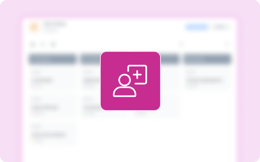
Employee Onboarding Template
Why efficient employee onboarding matters?
Employee onboarding is the first interaction an employee has with the organization right after the lengthy interview process.
- If the experience fails to live up to expectations, then your employee might regret their decision to accept the job offer.
- The negative impression left by a poor onboarding process might affect their perceptions, give them prejudiced notions about the organization, and ultimately cause them to quit early.
- A solid employee onboarding process is necessary to help your new hires settle down in their jobs, get to know the organization, obtain clarity on their job objectives, and forge a good relationship with other employees.
- A memorable onboarding experience not only makes employees feel welcome but also helps them gel with the existing organizational family faster.
- HR managers are burdened with enough as it is. Just the thought of tackling the humongous amount of paperwork involved in the onboarding process is enough to induce nightmares.
So, streamlining employee the onboarding process not only impresses new employees but also reduces the workload of the HR team.
Build faster, spend less. Kissflow quantifies the real impact of low-code adoption.
Benefits of using an employee onboarding automation
To avoid last-minute confusions and compliance issues, you need to have a solid employee onboarding process.
Here’s what an efficient employee management app does:
- Gives you a clearly outlined onboarding template
- Minimizes the chaos made by paperwork
- Shortens the employee onboarding lifecycle
- Reduces manual intervention and human errors
- Lessens the workload of the HR team
- Provides a consistent experience to all new hires
- Injects transparency into the process flow
- Offers the employees a memorable onboarding experience
Here’s a guide you can check out for effective onboarding solution
A good employee onboarding process flow
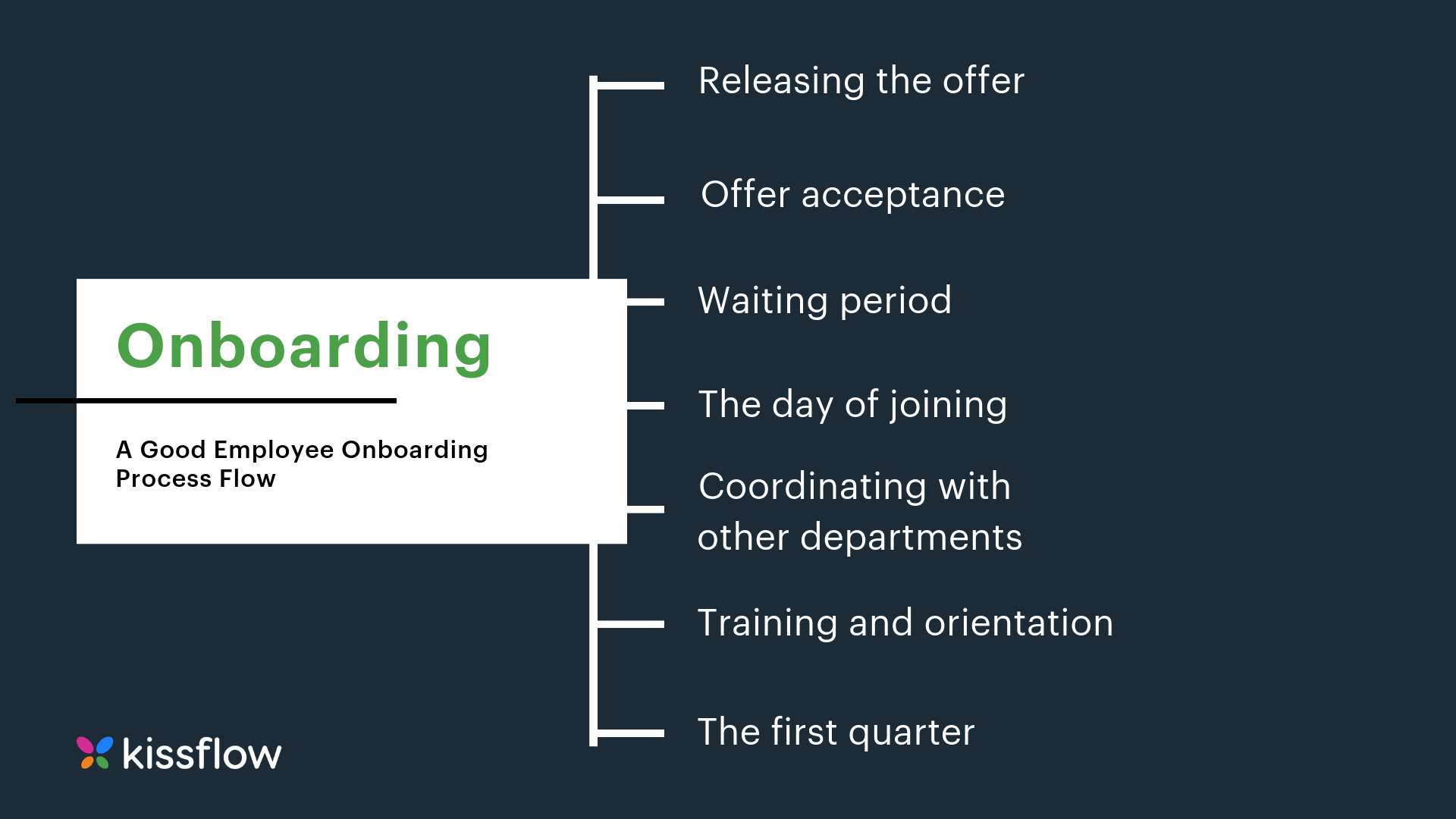
1. Releasing the offer
Employee onboarding process starts right after the recruitment phase. Once an employee is selected, an HR manager sends a warm welcome email with a few essential documents like the offer letter, links to fill out digital onboarding forms, and policy documents. Keeping the approach transparent familiarizes the employee with the organization’s culture and lets them know what to expect.
2. Offer acceptance
Once the employee accepts the offer, the best organizations will schedule a quick call to review the forms, benefits, policies, and set expectations. Keeping the new hires engaged will affirm their choice to accept the offer, and forge strong emotional ties with the organization. This is the right time to start sketching the agenda for employee orientation.
3. Waiting period
Just because an employee accepted the offer doesn’t promise that they’ll turn up for the date of joining. During the waiting period, the employee might be open to offers from other potential employers as well. So, it is critical to build a good rapport with the employee. Let the employee know they’re valued. It’s a good idea to also plan the waiting period when you’re designing your employee onboarding process
4. The day of joining
On the first day, most new hires have mixed emotions. They feel anxious, happy, excited, and nervous at the same time. So, the primary duty of HR managers is to ensure that the new hires feel welcome and comfortable. Invoking a sense of belonging in new hires will make them feel more committed and focus better on their work.
Having a handy employee onboarding checklist will relieve the stress of HR staff. Here are a few things to do before the day of joining:
- Keep the orientation schedule ready
- Assign IT assets (workstation, email access, etc.)
- Obtain necessary office supplies (furniture, keys, access card, etc.)
- Set up a salary account
- Assign a mentor or go-to-person who can help the employee settle down
5. Coordinating with other departments
It is essential to coordinate with key stakeholders (co-workers and managers) and notify them of the start date of the new hire. HR staff may enlist the help of other employees to decorate the new employee’s cubicle, organize one-on-one welcome meetings, and schedule an orientation session.
6. Training and orientation
Orientation sessions give the new hire an overview of the organization’s culture and an insight into company goals. This phase offers new hires relevant information about the teams within the company, team processes, and company policies. This is the right time to set role-based goals and objectives for the next 30/ 60/ 90 days to show the new hires what they need to focus on.
Since a major portion of employees require some essential training to get started, most organizations schedule the training program to bring their employees up to speed quickly. Doing an assessment of skills will help them employers gauge the new hires knowledge and ability and develop a personalized role-specific training plan in-tune with their skill set.
7. The first quarter
The major objective of this period is to review the expectations of the organizations and the employee and ensure they match. This phase needs to be filled with active dialogues about the progress and continued efforts of the new hire in becoming an integral part of the organization.
Here is an employee onboarding checklist list of to-do tasks that HR staff and the managers need to do for retaining the new hires long:
- Discuss the employee’s experience and check if it matches their expectations
- Review their performance and offer feedback
- Check whether the employee has any concerns or issues
- Talk about career planning and progression
- Retrieve feedback about onboarding and any suggestions
- Identify if they need any additional training
Revolutionize HR processes with low-code—streamline hiring, onboarding, and workforce management with ease.
Reinventing employee onboarding through automation
No matter how big the company, HR leaders tend to have too much on their plates. They spend enough time scavenging for the right resources, and by the time the onboarding starts, they are downright exhausted. Rather than adding to their fatigue by forcing them to do things the old fashioned way, automating the process can reduce their workload by a considerable amount.
Using HR workflow automation software, you can ditch the onboarding checklist and forms and eliminate manual dependency in the employee onboarding process. With automated employee workflow, the complex approval process can be simplified and streamlined. Also, the workflow would be mostly transparent, so retrieving information about the status or pinpointing the troubles would be a breeze.
With an automated onboarding app at work, you don’t have to chase after new hires and managers to complete the tasks assigned to them. The system takes care of it. Automatic notifications are sent to the right people who cause a delay in the workflow. The only time you have to intervene is when the system hits a roadblock.
In order to automate the workflow, you don’t have to invest a huge sum in an HR Management Software or depend on the IT team to develop sophisticated software. A simple workflow tool can automate the entire employee onboarding process end-to-end. Even HR staff with little to no technology exposure can create an automated workflow from scratch using the drag-and-drop interface or customize one of the predefined onboarding templates to suit their needs.
Conclusion
A good onboarding tool should give new employees a dose of motivation to explore the new organizational territory without a hint of hesitation.
With an automated onboarding process, new hires can spend less time buried under paperwork and use more time towards understanding the organizational values, exploring the workplace, and making new friends.
Tired of spending too much time on the employee onboarding? Is your IT Staff stretched too thin to customize a product for you? Looking for a simple and sleek tool which does the job efficiently? Kissflow HR Software is the answer to all your employee onboarding problems. Get a free demo to see how our employee onboarding app could make your problems fade like fog.
Digital transformation is essential for IT Leaders and Business Leaders alike. A low-code approach accelerates application development and workflow automation for enterprises.
Discover how Kissflow platform enhances HR performance management.
Automate Your Onboarding Process with Kissflow HR
Your search for HR has landed you here. Wondering why?
As a user, you'll experience the full value of Kissflow by implementing it across departments for diverse use cases rather than just addressing isolated needs like a project management tool for a single team or department.
Application Development Platform
Digital Transformation Platform
Related Articles
-May-19-2025-11-22-41-6975-AM.png)
